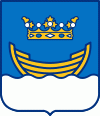Helsinki
 |
Together with the cities of Espoo, Vantaa, and Kauniainen (and surrounding commuter towns, including the eastern neighboring municipality of Sipoo ), Helsinki forms the Greater Helsinki metropolitan area, which has a population of over 1.5 million. Often considered to be Finland's only metropolis, it is the world's northernmost metro area with over one million people as well as the northernmost capital of an EU member state. After Copenhagen and Stockholm, Helsinki is the third largest municipality in the Nordic countries. Finnish and Swedish are both official languages. The city is served by the international Helsinki Airport, located in the neighboring city of Vantaa, with frequent service to many destinations in Europe, North America and Asia.
Helsinki was the World Design Capital for 2012, the venue for the 1952 Summer Olympics, and the host of the 52nd Eurovision Song Contest in 2007.
Helsinki has one of the world's highest standards of urban living. In 2011, the British magazine Monocle ranked Helsinki the world's most liveable city in its liveable cities index. In the Economist Intelligence Unit's 2016 liveability survey, Helsinki was ranked ninth among 140 cities. In July 2021, the American magazine Time ranked Helsinki one of the greatest places in the world in 2021 as a city that "can grow into a sprouting cultural nest in the future," and which has already been known in the world as an environmental pioneer. An international Cities of Choice survey conducted in 2021 by the consulting firm Boston Consulting Group and the BCG Henderson Institute raised Helsinki the third best city in the world to live, with London and New York City ranking the first and the second. Also, together with Rovaniemi in the Lapland region, Helsinki is one of Finland's most significant tourist cities in terms of foreign tourism. Due to the large number of sea passengers per year, Helsinki is classed as a Large-Port City.
According to a theory presented in the 1630s, at the time of Swedish colonisation of coastal areas of Finland, colonists from Hälsingland in central Sweden had arrived at what is now known as the Vantaa River and called it Helsingå ('Helsinge River'), which gave rise to the names of Helsinge village and church in the 1300s. This theory is questionable, because dialect research suggests that the settlers arrived from Uppland and nearby areas. Others have proposed the name as having been derived from the Swedish word helsing, an archaic form of the word hals ('neck'), referring to the narrowest part of a river, the rapids. Other Scandinavian cities at similar geographic locations were given similar names at the time, e.g. Helsingør in Denmark and Helsingborg in Sweden.
When a town was founded in Forsby village (later known as Koskela) in 1548, it was named Helsinge fors, 'Helsinge rapids'. The name refers to the Vanhankaupunginkoski rapids at the mouth of the river. The town was commonly known as Helsinge or Helsing, from which the contemporary Finnish name arose.
Official Finnish Government documents and Finnish language newspapers have used the name Helsinki since 1819, when the Senate of Finland moved itself into the city from Turku, the former capital of Finland. The decrees issued in Helsinki were dated with Helsinki as the place of issue. This is how the form Helsinki came to be used in written Finnish. As part of the Grand Duchy of Finland in the Russian Empire, Helsinki was known as (Гельсингфорс) in Russian.
In Helsinki slang, the city is called Stadi (from the Swedish word stad, meaning 'city'). People from other areas of Finland might use Hesa (short for Helsinki). Helsset is the Northern Sami name for Helsinki.
Map - Helsinki
Map
Country - Finland
 |
 |
| Flag of Finland | |
Finland was first inhabited around 9000 BC after the Last Glacial Period. The Stone Age introduced several different ceramic styles and cultures. The Bronze Age and Iron Age were characterized by contacts with other cultures in Fennoscandia and the Baltic region. From the late 13th century, Finland became a part of Sweden as a consequence of the Northern Crusades. In 1809, as a result of the Finnish War, Finland became part of the Russian Empire as the autonomous Grand Duchy of Finland, during which Finnish art flourished and the idea of independence began to take hold. In 1906, Finland became the first European state to grant universal suffrage, and the first in the world to give all adult citizens the right to run for public office. After the 1917 Russian Revolution, Finland declared independence from Russia. In 1918, the fledgling state was divided by the Finnish Civil War. During World War II, Finland fought the Soviet Union in the Winter War and the Continuation War, and Nazi Germany in the Lapland War. It subsequently lost parts of its territory, but maintained its independence.
Currency / Language
| ISO | Currency | Symbol | Significant figures |
|---|---|---|---|
| EUR | Euro | € | 2 |
| ISO | Language |
|---|---|
| FI | Finnish language |
| SV | Swedish language |
















